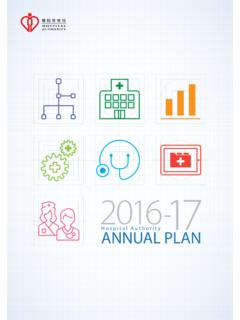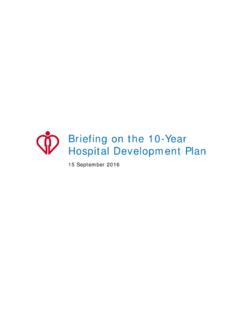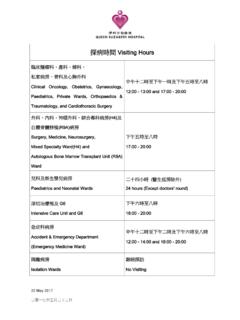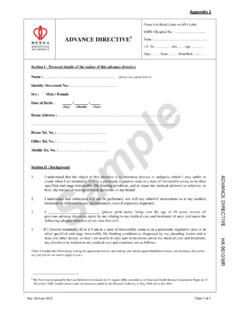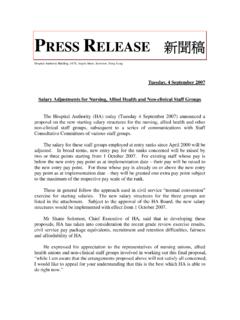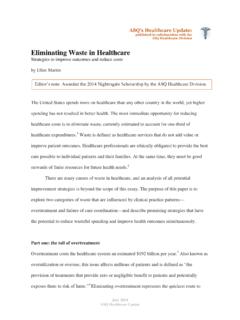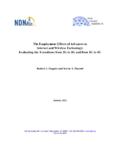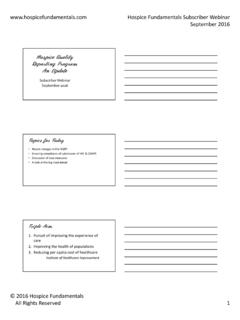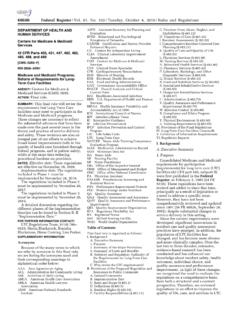Transcription of Hospital Authority Quality & Risk Management …
1 Hospital Authority Quality & Risk Management annual Report2009 - 2010(Apr 09 - Mar 10) ACKNOWLEDGEMENT We would like to express our deepest appreciation of the support from all frontline colleagues, Hospital risk managers, clinicians, executives of hospitals, and colleagues of cluster Quality and risk Management departments in improving patient safety. We would also like to thank them for their contributions in the risk mitigation strategies and programmes. Patient Safety and Risk Management Department Quality and Safety Division 1 TABLE OF CONTENTS Opening Message 3 Head Office Chapter 4 Hong Kong East Cluster Chapter 12 Hong Kong West Cluster Chapter 28 Kowloon Central Cluster Chapter 44 Kowloon East Cluster Chapter 60 Kowloon West Cluster Chapter 76 New Territories East Cluster Chapter 92 New Territories West Cluster Chapter 1082 Opening Message This is the second publication of the Hospital Authority Quality and Risk Management annual report, compiled by the Patient Safety and Risk Management Department, Quality & Safety (Q&S) Division.
2 The purpose is to facilitate sharing of Quality and Safety practices across the Hospital Authority (HA). Over the past few years, the HA Head Office (HAHO) Quality and Safety team has made annual visits to all seven HA clusters for an informal exchange with cluster Quality and Safety teams, HCEs and CCEs. The purpose was to review on-going Quality and Safety programs at the cluster and Hospital levels and to discuss Quality and Safety plans and programs for the coming year. We have been most impressed that all seven clusters have set up a framework and structure to oversee Quality and Safety work, as well as defined key processes and taken forward Quality and Safety programs.
3 With the on-going accreditation process, we have also observed evaluation and Continuous Quality Improvement as part of our routine work. We trust this annual publication will further enhance the learning and sharing culture across HA as this is a key element in the quest by HA to ensure effective, efficient and safe healthcare for our patients. Dr. SF Lui, Consultant (Q&S), HAHO for Q&S Division, HAHO 3 1. Structure & Initiatives This chapter details the patient safety and Quality Management initiatives implemented in 2009/10. Quality in health care has various dimensions, which cover patient care Quality , professional Quality and Management Quality , and a complimentary multi-pronged approach is necessary.
4 In 2009/10, the Quality and Standard Department focused on several key areas establishing Quality Management system, access Management , communication and sharing, and clinical measurement. The Patient Safety and Risk Management Department serves patients by spearheading, creating and refining our system designs and care processes so as to reinforce patient safety. These designs are further enhanced by the appropriate use of information system and technology. We emphasize the development of staff capability and new competencies to cope with the ever changing healthcare environment and increasing expectations of our community. In order to facilitate reporting and share the lessons learned, we strive to improve our incident reporting and Management system.
5 We also target at proper data analysis so as to Patient Safety & Risk ManagementQuality & Standards 4 identify clinical risk, formulate service plans to tie in with resources, transform our healthcare environment and provide a safer and more efficient healthcare to our patients. A Systematic Approach to Continuous Quality Improvement Hospital Accreditation In its Quality journey, HA has developed a set of patient care standards to promote Quality and safety as an integral part of its annual planning process. However, by adopting a self-assessment approach, the HA Quality and safety system is not perceived to be as robust or credible as other external Hospital accreditation systems, particularly in face of the ever-rising public expectations for both Quality and information of services provided.
6 Hospital accreditation offers a formal, structured and systematic evaluation of Hospital services, and is well recognized as a proven tool for continuous Quality improvement (CQI) in the healthcare support and collaboration from the Government, the Private Hospitals Association (PHA) and the Department of Health (DH), HA launched the Pilot Scheme of Hospital Accreditation (Pilot Scheme) in May 2009 in close partnership with an international accrediting agent, the Australian Council on Healthcare Standards (ACHS). The main objectives of the Pilot Scheme are to establish the infrastructure of accreditation, assess the feasibility of implementing an accreditation program, enhance public-private collaboration and evaluate and recommend on the future model of accreditation in Hong Kong (HK).
7 Private hospitals have also procured services directly from ACHS on their own. Five public hospitals, namely CMC, PYNEH, QMH, QEH and TMH as well as 3 private hospitals, namely the Baptist Hospital , Hong Kong Sanatorium & Hospital and Union Hospital voluntarily joined the Pilot Scheme. Central to introducing the concept of accreditation as a framework and process for CQI in HA is soliciting support and participation of key stakeholders. The Pilot Scheme was launched with intensive engagement and training programs which have substantially enhanced the awareness of and support to accreditation. 5 Consultancy surveys by teams of Australian surveyors were conducted in the 5 pilot (public) hospitals in December 2009 to identify their readiness for Organization-wide Survey (OWS) to attain accreditation status.
8 The survey teams revealed strong leadership and commitment to Quality and engagement of all staff groups, as well as various innovations and achievements in prioritized risk areas, such as patient identification, medication safety and informed consent. Some common areas for improvement, such as sterilization practice of reusable surgical instruments in Operating Theatres, credentialing and documentation Management were identified for hospitals to align with the international standards. The pilot hospitals have scheduled their OWS in the latter half of 2010. Given the differences between Australia and HK in local culture, healthcare practice, laws and regulation, a Task Force on Standards co-chaired by representatives of HA and PHA was established to review application of the latest ACHS Evaluation and Quality Improvement Program (EQuIP) in HK.
9 By involving experts and inviting feedback from stakeholders and patient groups, the Task Force aimed at developing a HK version of EQuIP 4 recognized by ACHS and The International Society for Quality in Health Care (ISQua). Trained and experienced surveyors and a robust surveyor system are key to all accreditation programs. By adopting a systematic surveyor training, evaluation and appointment program in partnership with ACHS, the Pilot Scheme has successfully trained and appointed 21 local health care professionals as ACHS(Hong Kong) Surveyors who will be given the same recognition and status as ACHS surveyors in March 2010. Access Management In 2009/10, HA identified pressures areas in its service and standardized the data definitions in measuring their waiting time.
10 By collating information from multiple modules of the Clinical Management System, the Management could monitor the key indicators through real-time data in specialist outpatient (SOP) services, elective surgeries and radiology services. Through discussions in various task forces on waiting time, specific programs addressing the 6 pressure areas were developed. HA also identified elective surgeries for cancer, cataract and joint replacement, diagnostic imaging and SOP services as the key pressure areas. To prepare for the launching of the Pay-for-Performance Quality Incentive Program in 2010/11, SOP and cancer waiting time have been included as the indicators for performance measurement. Clinical-based electronic referral system has been piloted in 3 clusters (HKEC, KCC and NTWC) since early 2010 to enhance feedback mechanism between referral sources and receiving ends to facilitate effective communication and HA will further develop e-transfer and e-triage according to the master development plan.

